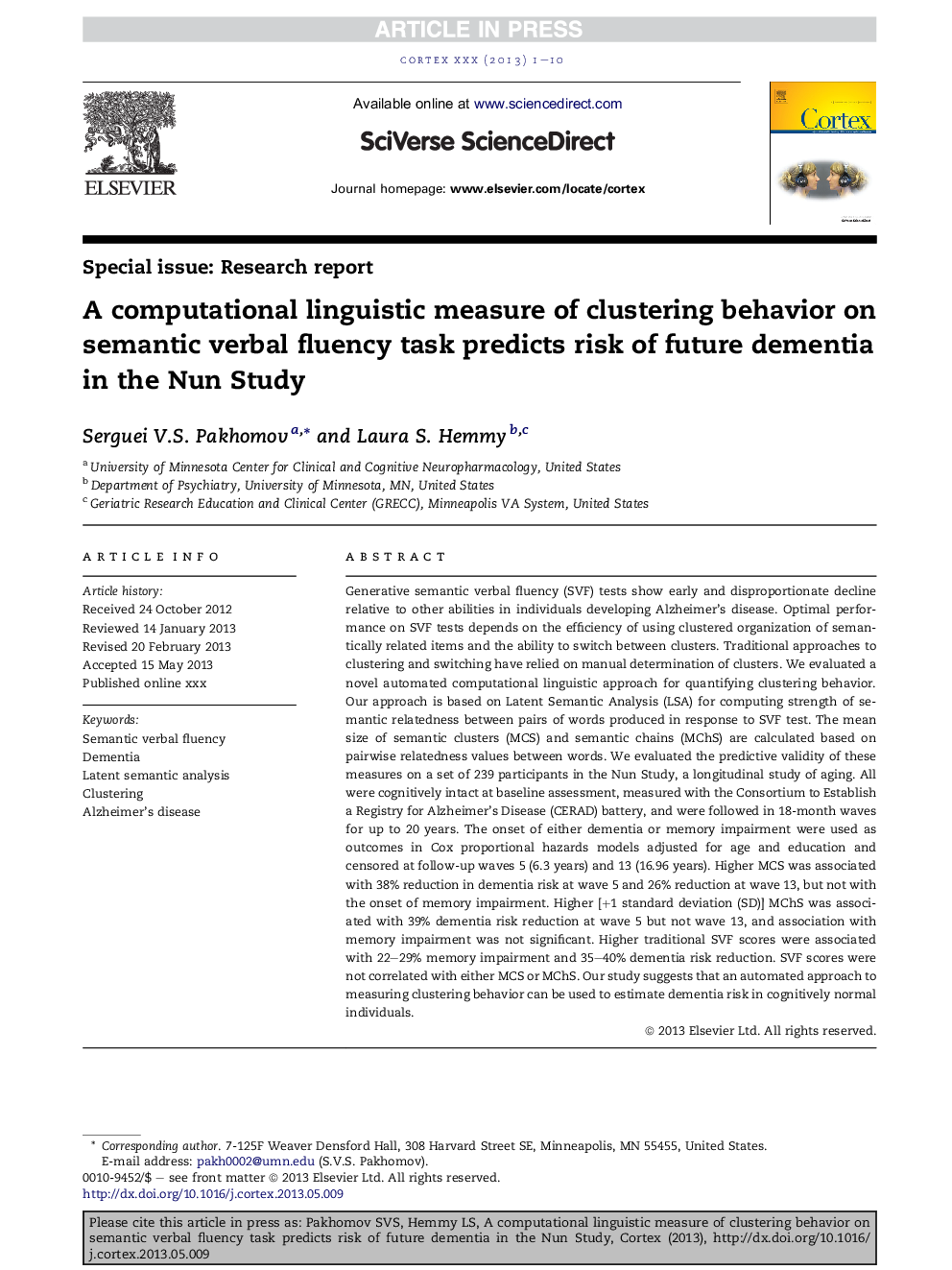| کد مقاله | کد نشریه | سال انتشار | مقاله انگلیسی | نسخه تمام متن |
|---|---|---|---|---|
| 7315607 | 1475477 | 2014 | 10 صفحه PDF | دانلود رایگان |
عنوان انگلیسی مقاله ISI
A computational linguistic measure of clustering behavior on semantic verbal fluency task predicts risk of future dementia in the Nun Study
ترجمه فارسی عنوان
معیار زبانی محاسبهی رفتار خوشهبندی بر روی کارکرد روانشناختی معناشناختی خطر ابتلا به زوال عقل در آینده را در مطالعه نون پیشبینی میکند
دانلود مقاله + سفارش ترجمه
دانلود مقاله ISI انگلیسی
رایگان برای ایرانیان
کلمات کلیدی
روانشناسی معنایی، کم خونی تجزیه و تحلیل معنایی بالقوه، خوشه بندی بیماری آلزایمر،
موضوعات مرتبط
علوم زیستی و بیوفناوری
علم عصب شناسی
علوم اعصاب رفتاری
چکیده انگلیسی
Generative semantic verbal fluency (SVF) tests show early and disproportionate decline relative to other abilities in individuals developing Alzheimer's disease. Optimal performance on SVF tests depends on the efficiency of using clustered organization of semantically related items and the ability to switch between clusters. Traditional approaches to clustering and switching have relied on manual determination of clusters. We evaluated a novel automated computational linguistic approach for quantifying clustering behavior. Our approach is based on Latent Semantic Analysis (LSA) for computing strength of semantic relatedness between pairs of words produced in response to SVF test. The mean size of semantic clusters (MCS) and semantic chains (MChS) are calculated based on pairwise relatedness values between words. We evaluated the predictive validity of these measures on a set of 239 participants in the Nun Study, a longitudinal study of aging. All were cognitively intact at baseline assessment, measured with the Consortium to Establish a Registry for Alzheimer's Disease (CERAD) battery, and were followed in 18-month waves for up to 20 years. The onset of either dementia or memory impairment were used as outcomes in Cox proportional hazards models adjusted for age and education and censored at follow-up waves 5 (6.3 years) and 13 (16.96 years). Higher MCS was associated with 38% reduction in dementia risk at wave 5 and 26% reduction at wave 13, but not with the onset of memory impairment. Higher [+1 standard deviation (SD)] MChS was associated with 39% dementia risk reduction at wave 5 but not wave 13, and association with memory impairment was not significant. Higher traditional SVF scores were associated with 22-29% memory impairment and 35-40% dementia risk reduction. SVF scores were not correlated with either MCS or MChS. Our study suggests that an automated approach to measuring clustering behavior can be used to estimate dementia risk in cognitively normal individuals.
ناشر
Database: Elsevier - ScienceDirect (ساینس دایرکت)
Journal: Cortex - Volume 55, June 2014, Pages 97-106
Journal: Cortex - Volume 55, June 2014, Pages 97-106
نویسندگان
Serguei V.S. Pakhomov, Laura S. Hemmy,
